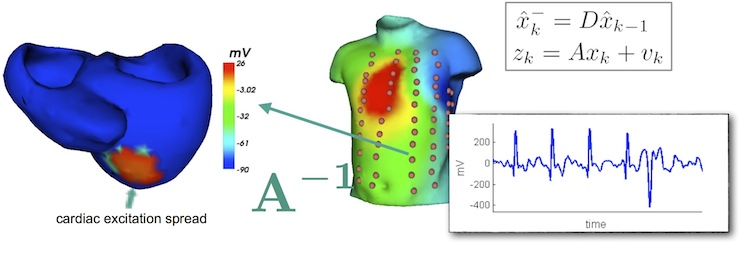Imposition of Dynamic Model Based Regularization on the Solution in ECG Imaging
- chair:Inverse problem of ECG
- type:Bachelor thesis
- tutor:
- person in charge:
-
Motivation
ECG imaging (ECGI) is a new technique for the non-invasive visualization of electrical activity in the heart. In a clinical cooperation with the University Hospital Mannheim, we are validating the imaging method with patients that suffer from ventricular extrasystoles (VES). Patients undergo magnetic resonance imaging scans to generate computermodels of the thorax and heart. Later, in the electrophysiology laboratory (EP lab), a map of body surface extracellular potentials (BSPM) is recorded while catheter signals are collected in the human heart during an interventional procedure. The catheter signals serve as a validation reference for the method.
By solving the inverse problem of electrocardiography we reconstruct transmembrane voltages in the myocardium from the BSPM signals. To obtain the reconstruction, a linear inverse problem has to be solved that is severely ill-posed: the body is a low-pass filter and any high-frequent noise in the BSPM is therefore considered by the solver to have a strong impact on the signals in the heart.
For stabilization of the method spatial smoothing is typically applied. However, this representation of a-priori knowledge makes little use of what is known about the behavior of the solution in time. Recent research by Wang et al. has shown that models of cardiac excitation spread can be used to track the excitation spread in the heart using an unscented Kalman filter.

Tasks
In the project, the unscented Kalman filter will be implemented to solve the inverse problem of electrocardiography. Suitable models of the cardiac anatomy and dynamics will be chosen to produce predictions of the excitation spread.Requirements
- programming skills in MATLAB
- basic understanding of signal processing and control theory

